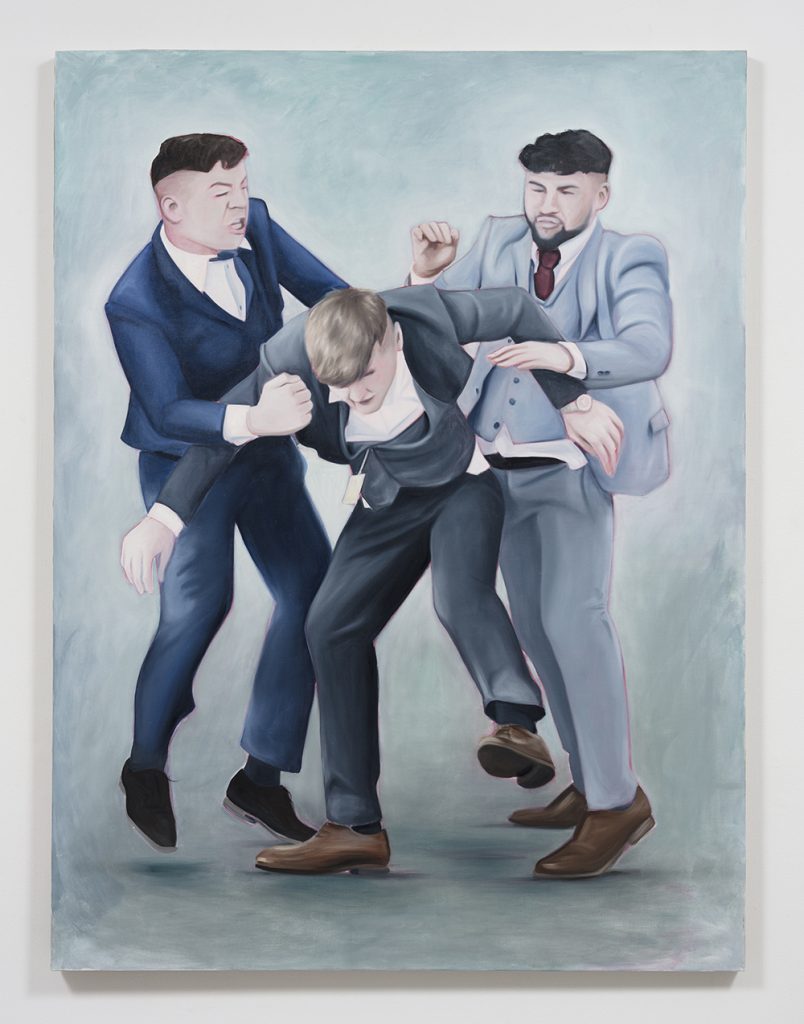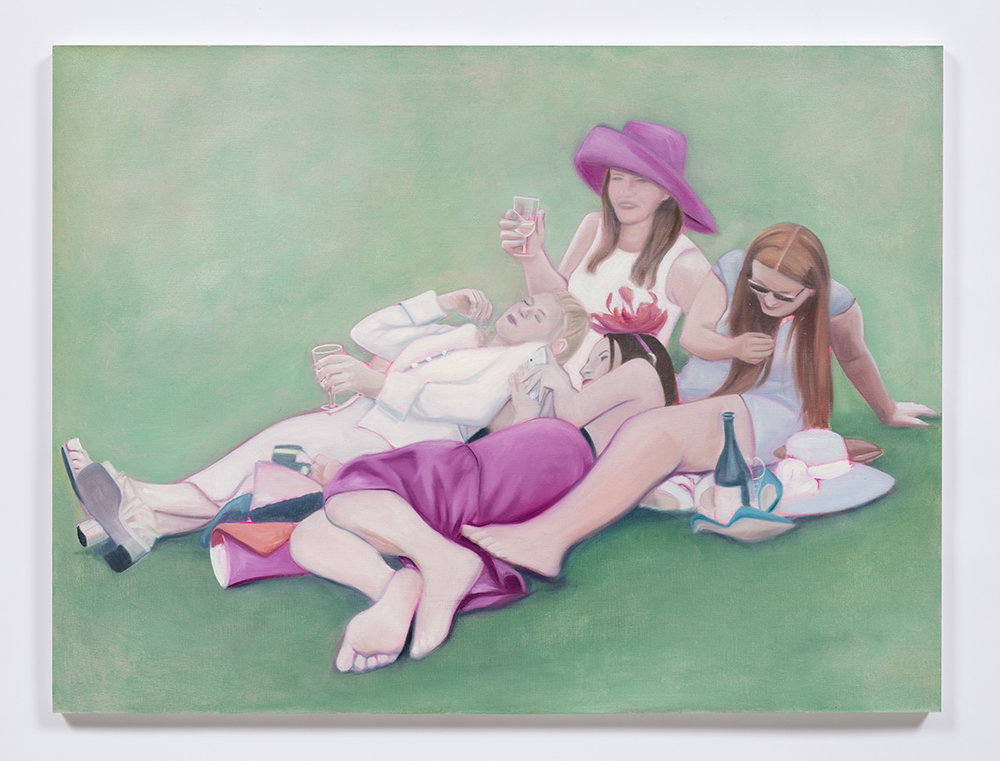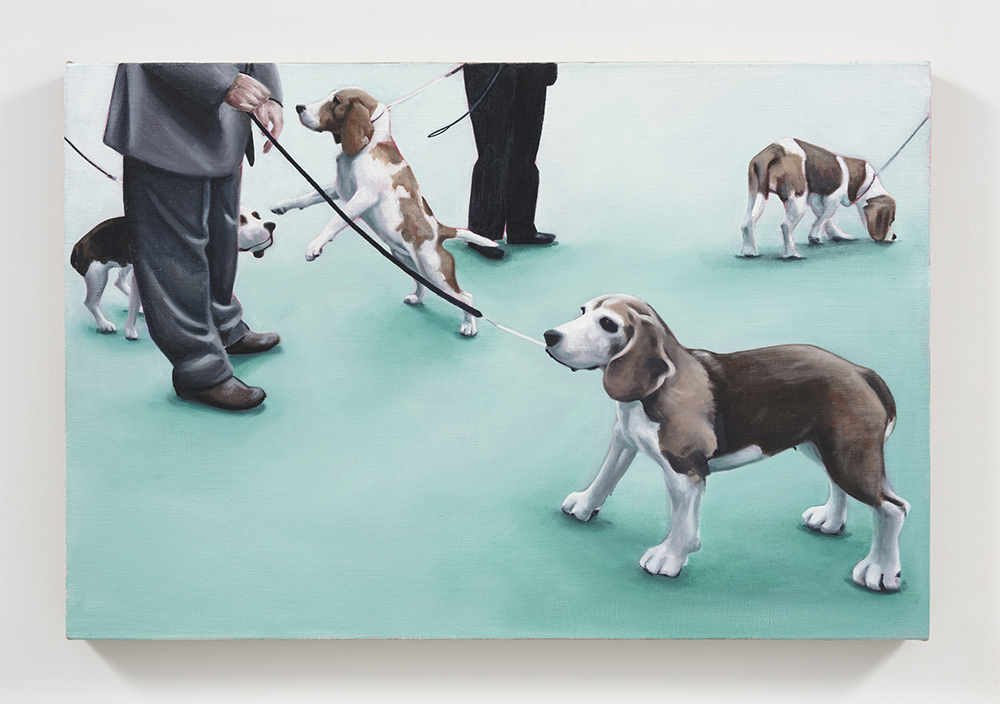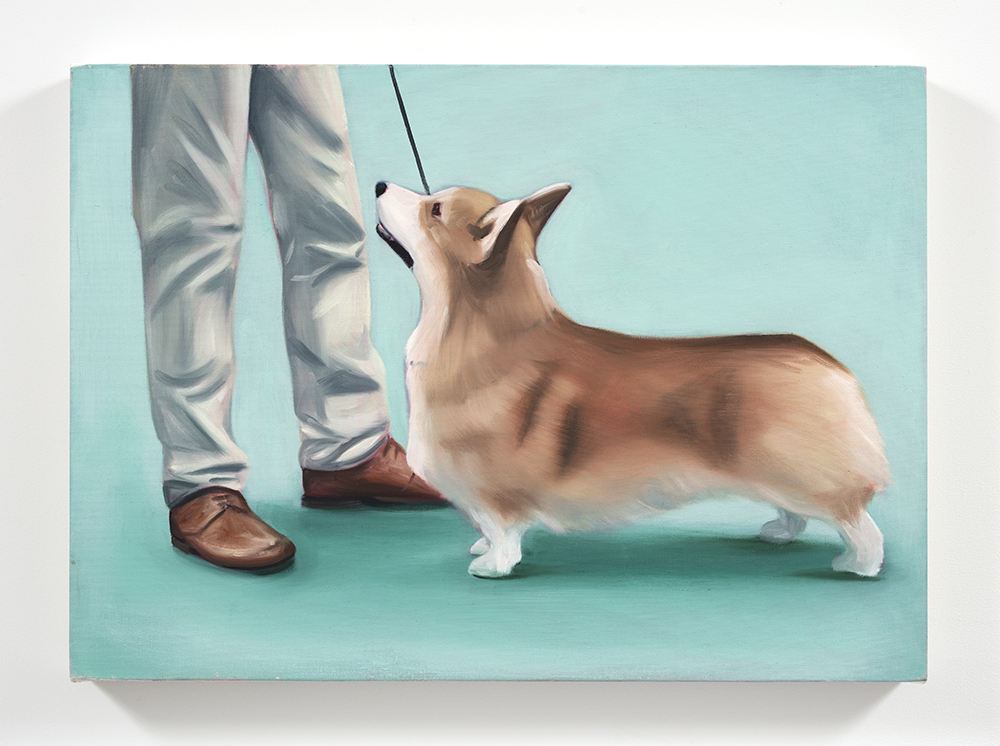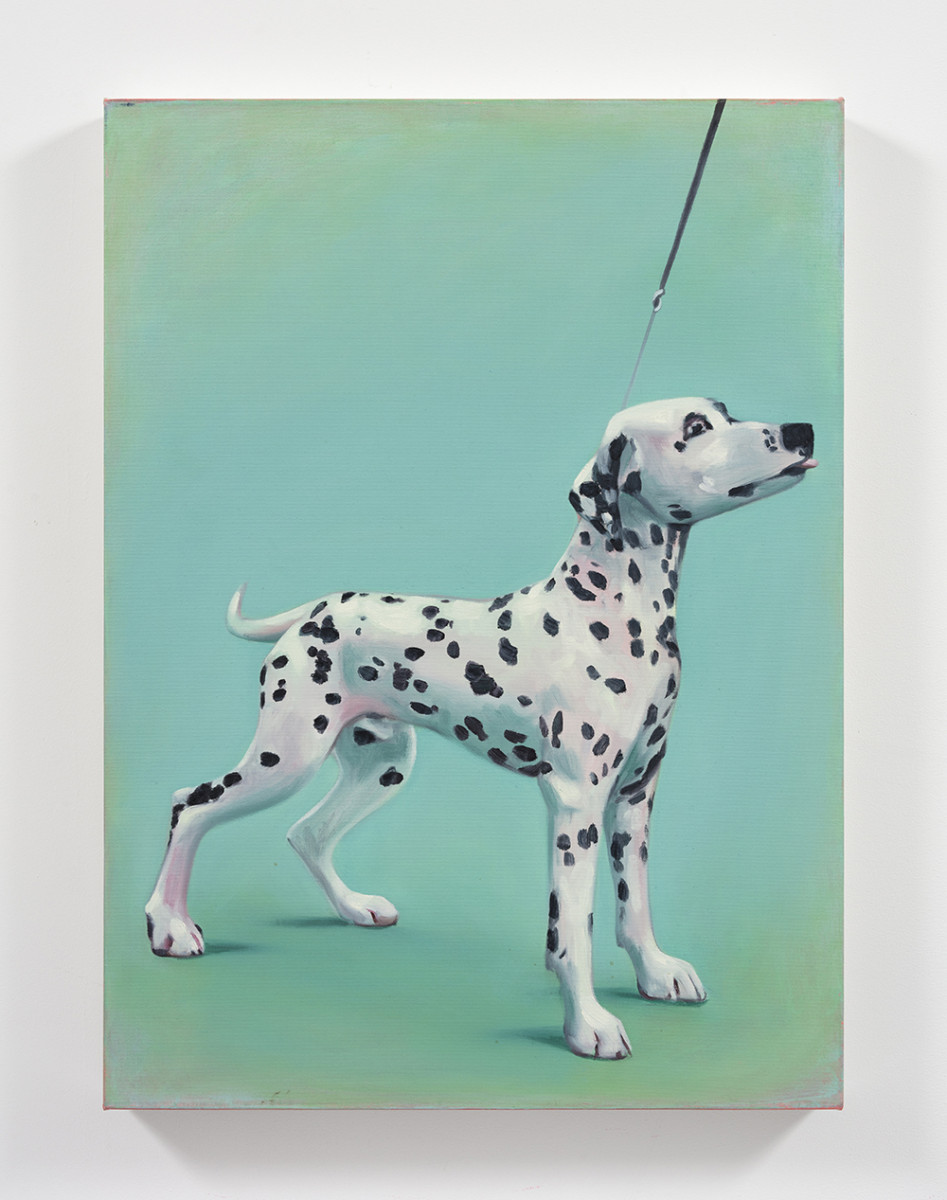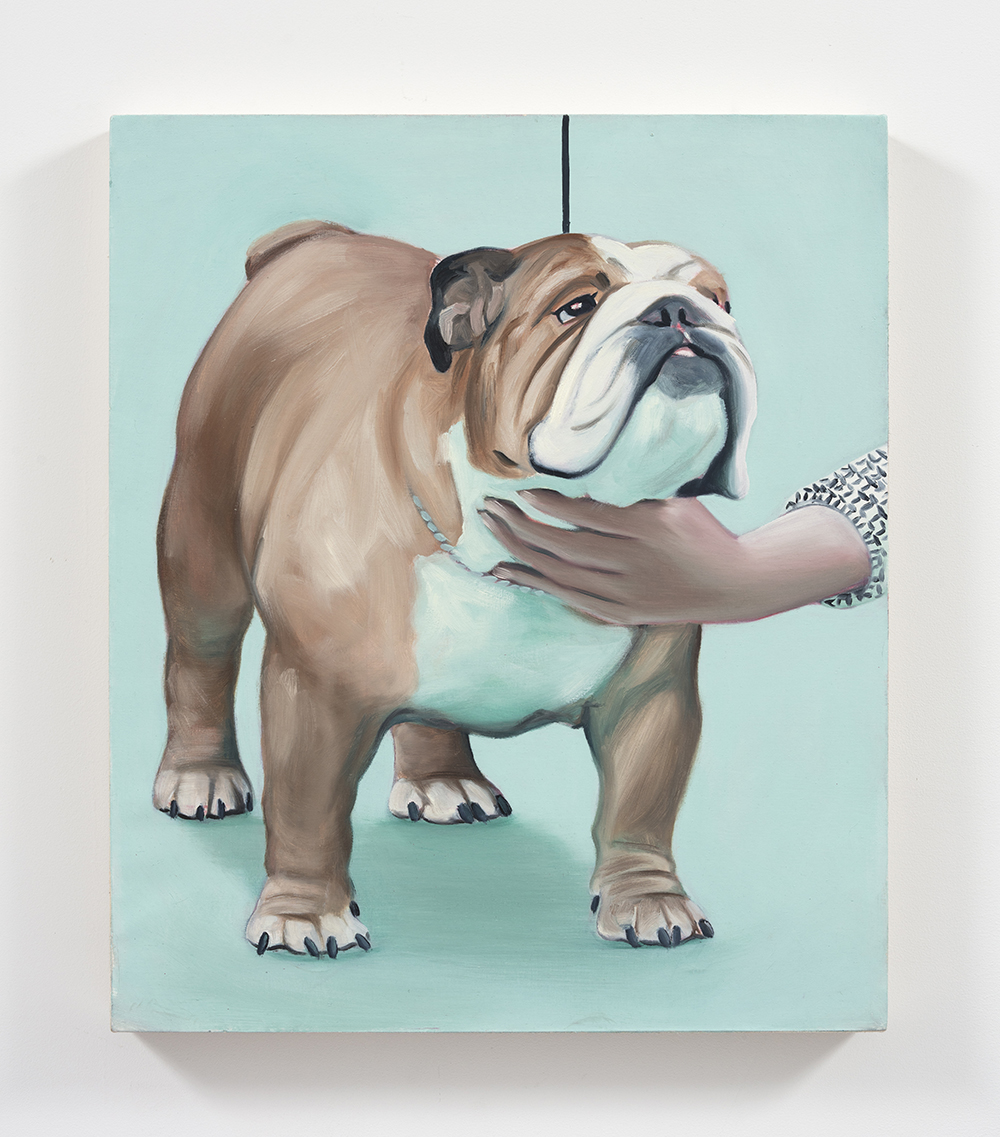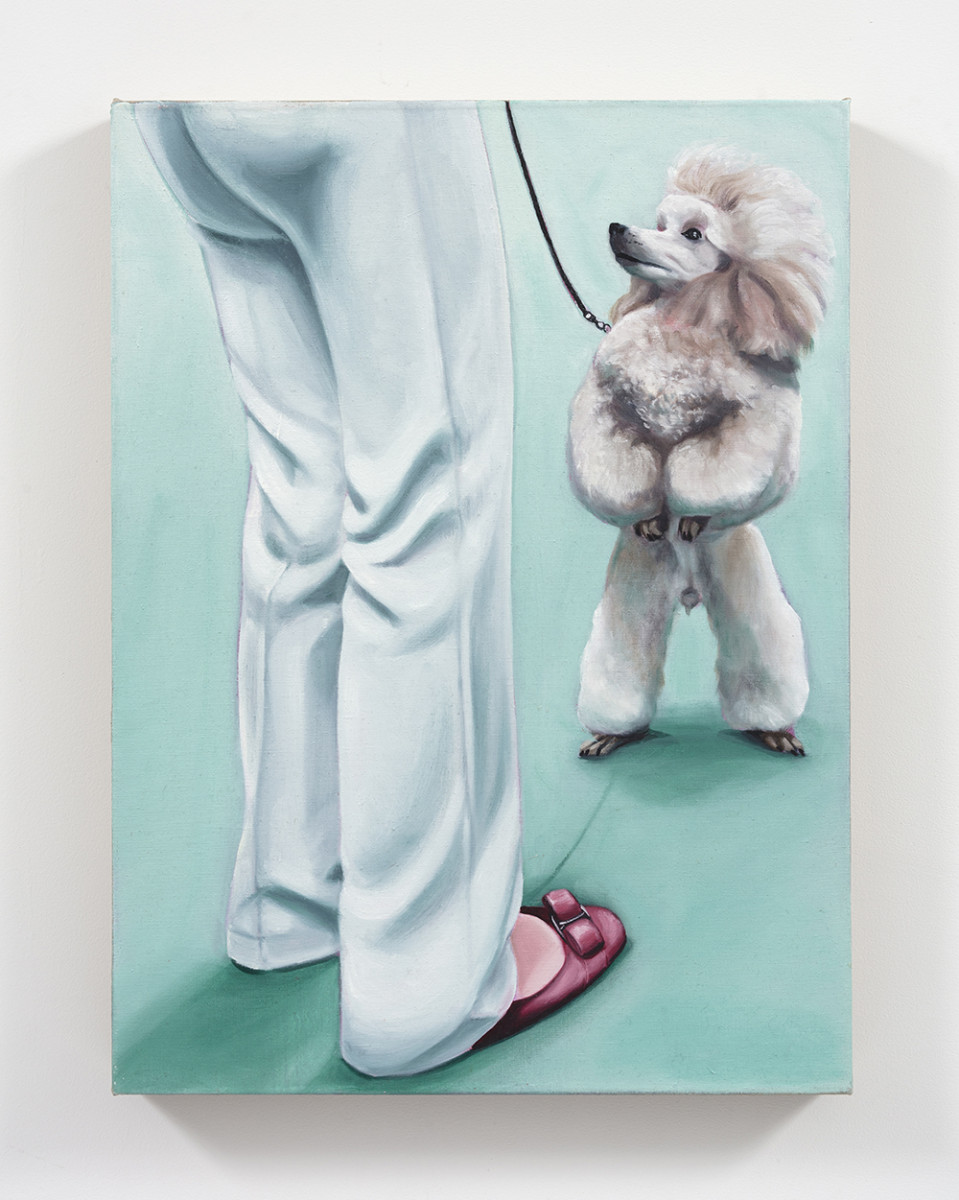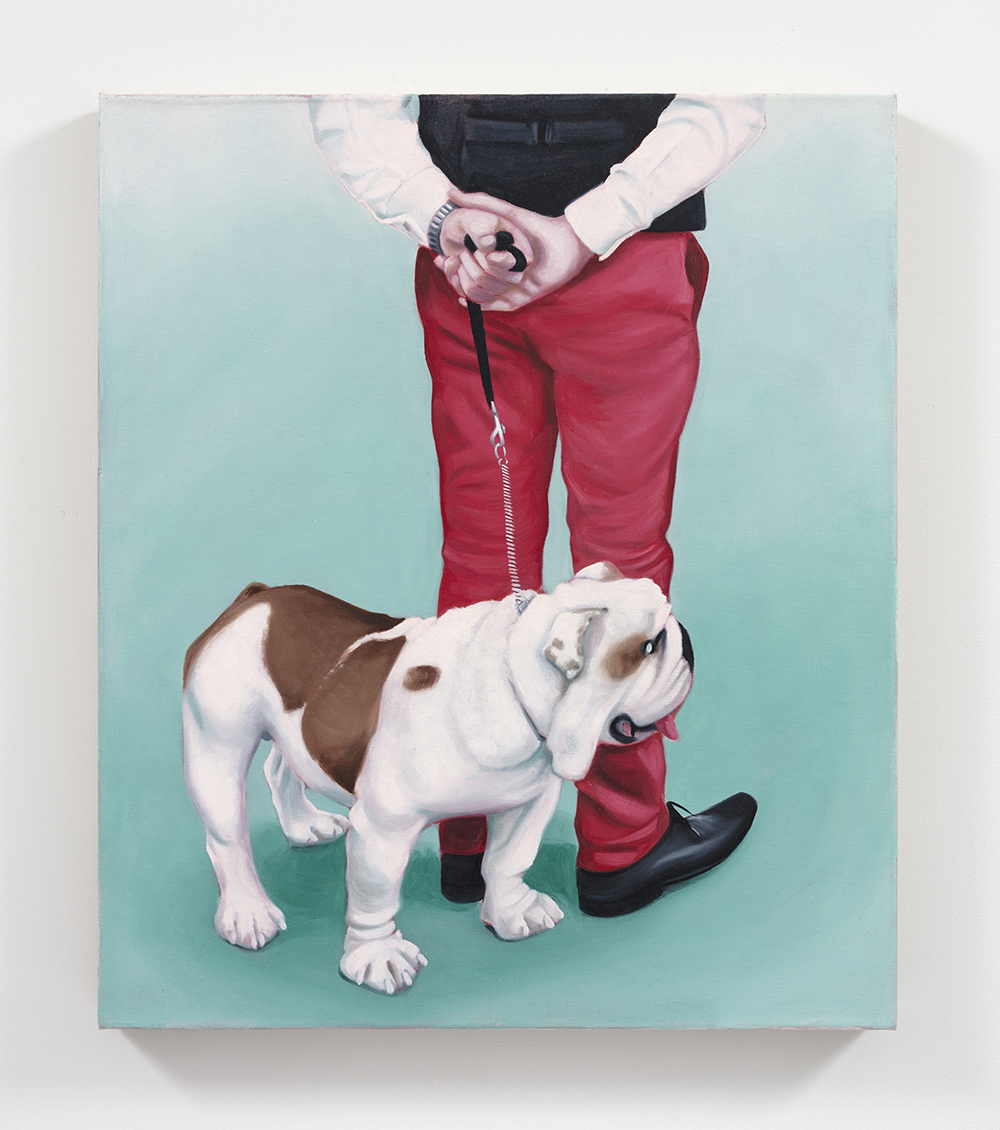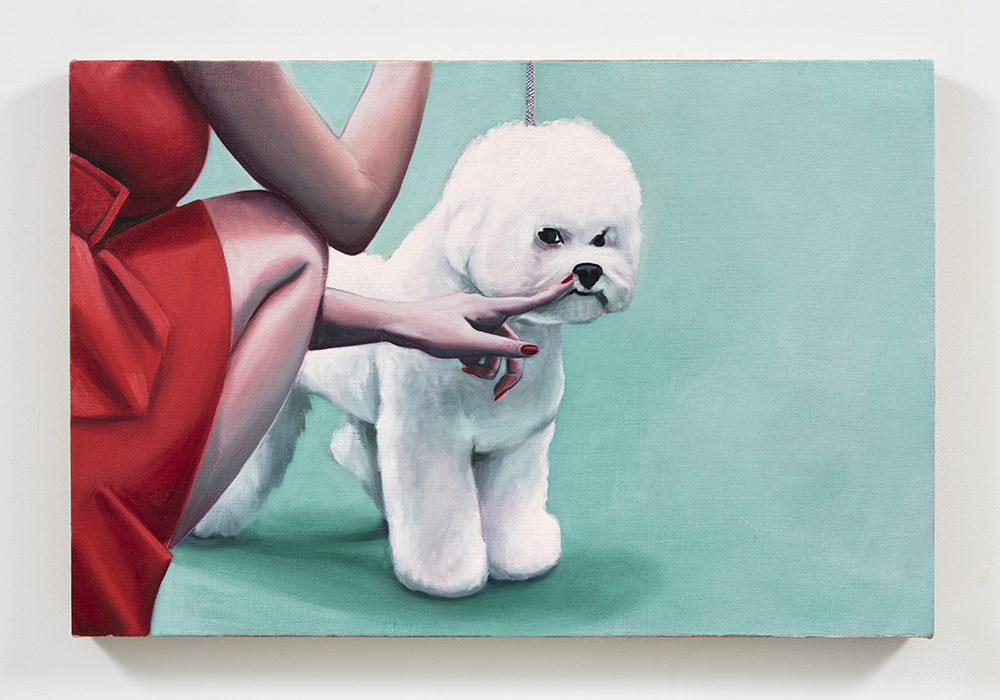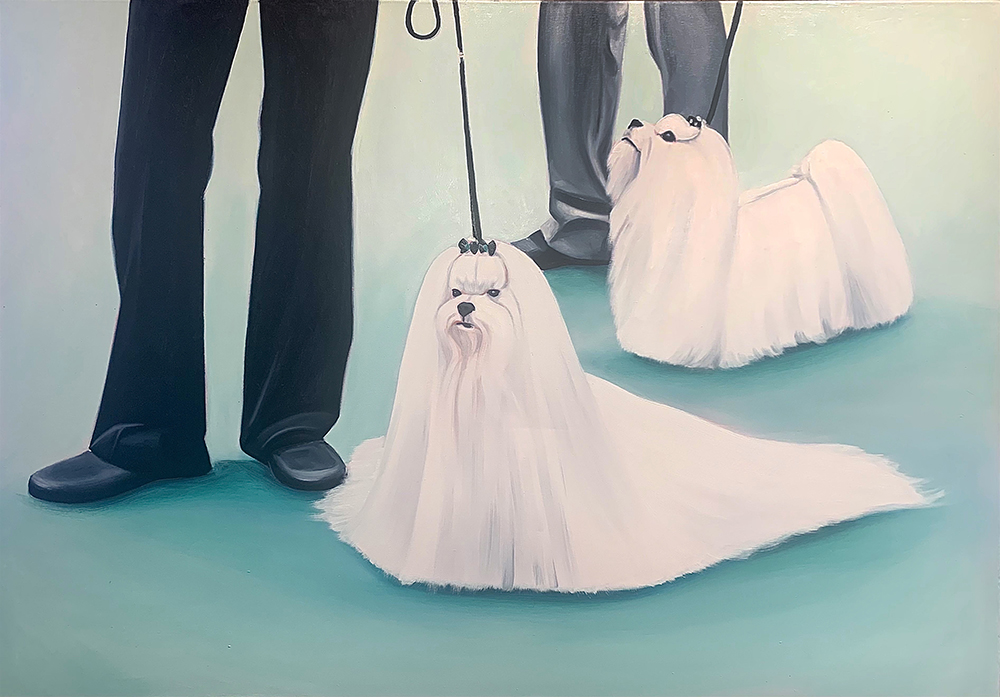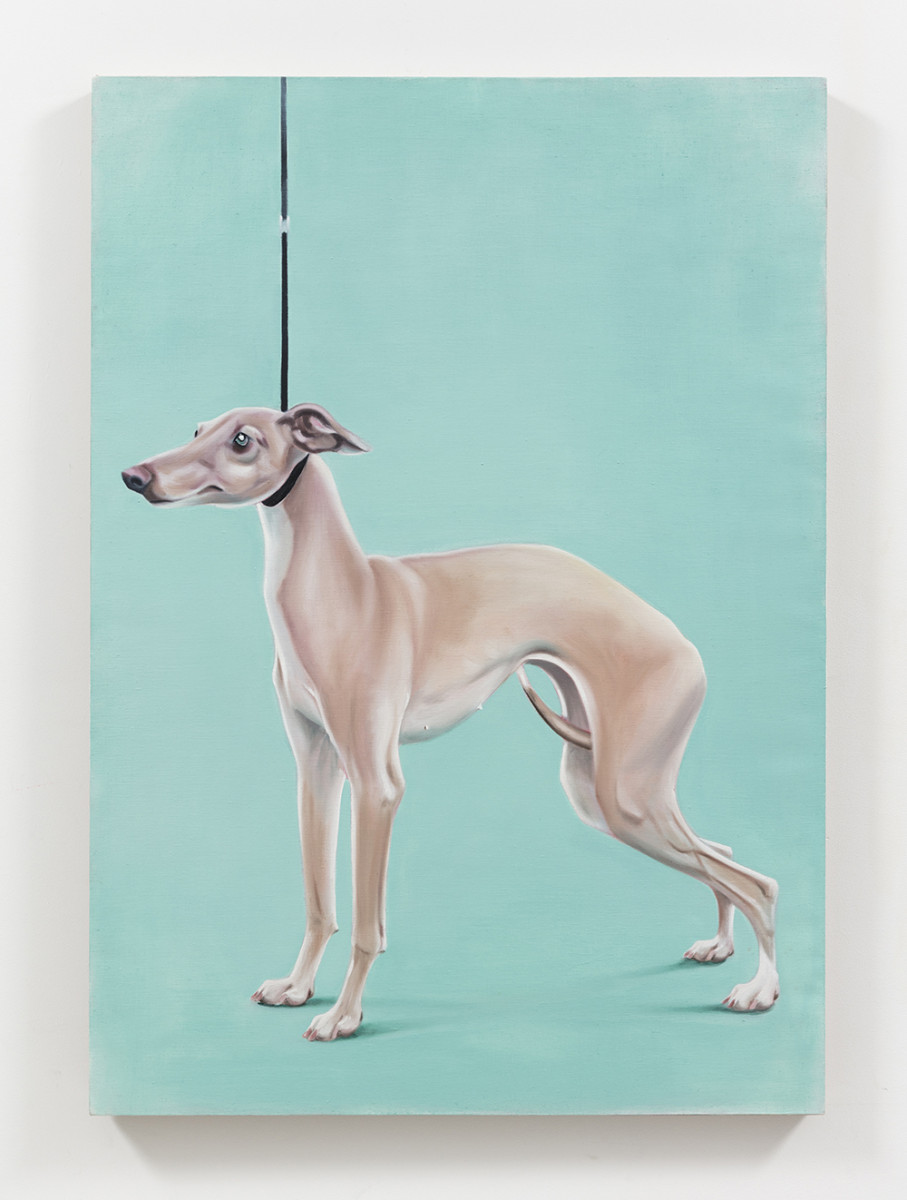Steve Turner is pleased to present Dog Show, an online solo exhibition of new paintings by Lydia Blakeley that depict dogs and their owners in competition at British dog shows. Positioned against a background of green, Blakeley puts the dogs in the leading role while their owners are the supporting actors. Part status symbol and part family member, the dogs symbolize prestige, loyalty and protection. According to Blakeley, “there is something captivating about the dogs’ expressions. They are endearing, and I like to think of these paintings as little scenes from one big performance.”
Lydia Blakeley (b. 1980, Bracknell, Berkshire, England) earned an MFA at Goldsmiths, London (2019) and a BFA at Leeds College of Art (2016). She has had solo exhibitions at Niru Ratnam Gallery, London (2020); Alessandro Albanese Gallery, Matera (2020); Vortic London Collective, Hannah Barry Gallery, London (2020); Steve Turner, Los Angeles (2020); PlazaPlaza, London (2019): J Hammond Projects, London (2019); SET, London (2019) and Paradise Works, Manchester (2019). Dog Show is Blakeley’s second solo exhibition with Steve Turner. She lives and works in North Yorkshire, England.
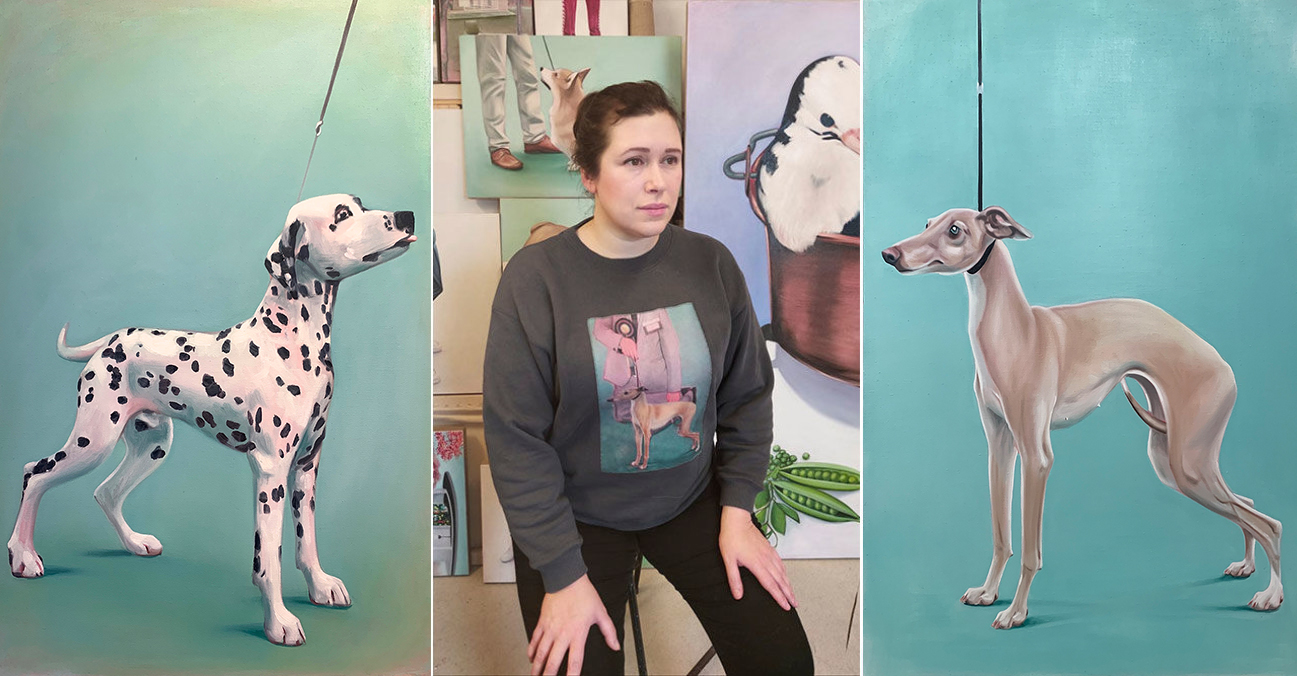
Steve Turner:
Before we talk about your lovely paintings in Dog Show, would you describe your family background, where you grew up and the circumstances of your youth.
Lydia Blakeley:
I was born in a town called Bracknell in 1980 and grew up in various places in the area. Bracknell is what is known as a ‘New Town’, designed in the 1950s for the overspill from London. It was designed to be ideal for aspirational working and middle class families in an area that had a lot of industry at the time. Sadly, those manufacturers started to disappear in the 1980’s. My Mum was a teacher, Dad worked in logistics and I have an older brother.
ST:
Did you have any particularly strong interests at this time? Any interest in art?
LB:
Art was always the subject I enjoyed the most at school, a subject that I gave the most to and the one that I did best in. Once we could choose options of what to study it was always top of my list. But for some reason, and also due to the poor career guidance at school, I didn’t think it would be practical to study art in college. As a consequence, I started working in retail and hospitality.
ST:
Did you enjoy those jobs? What prompted you to go back to school when you did? Where did you go and what did you study?
LB:
Working in retail proved to be a good career and I was able to work my way up to Store Manager for a number of businesses. Following the global financial crash in 2008 there started to be changes to the industry. If anyone on my team left we could not replace them. With less staff everyone was stretched and the environment became less rewarding.
During those years I also took a number of evening courses at local colleges as well as art classes with various community groups. In doing so, I accumulated a portfolio of work with which to apply to various colleges. When I was accepted at Leeds College of Art in 2013, I jumped at the opportunity. It was the best thing I ever did. I enrolled in the three-year BA program in fine art. Following that, I earned a teaching qualification at the University of Huddersfield and then went on to complete an MFA Fine Art at Goldsmiths, University of London starting in 2017 and graduating in 2019.
ST:
What made your experience at Leeds College so beneficial? Do you think starting college at a slightly older age was advantageous?
LB:
As a more mature student who had left a successful career in favor of a new opportunity, I was determined to make a success of my time at college. In the UK they had just increased tuition fees, so I saw college as a serious commitment, sort of like an investment. I immersed myself in my studio and also sought to expand my knowledge. It was especially inspiring to be at Leeds College of Art, a relatively small institution, and one that is entirely focused on the creative arts. It was good to develop my art practice at a regional art school where I had lovely peers who were accepting and encouraging. I created friendships which endure to this day.
ST:
And what about Goldsmiths? What was your experience like there?
LB:
Goldsmiths was also an incredible experience. I would not be where I am today if I hadn’t been in that program. It was extremely different from Leeds and was quite competitive in some respects. The whole time I was there, I felt entirely out of my depth, as though I was an imposter.
The program was very interesting, and I greatly benefited from the high level of critical engagement through the lectures and seminars. While I was in my studio most of the time, I also took advantage of being in London and used social media to reach a broader audience. I started to schedule studio visits and was able to meet so many new artists and gallerists. I expected that I might not be able to remain in London after I graduated, so I made the most of my time there.
There weren’t many painters in my year, so as a “rare breed,”, I felt that I had to really defend painting which some students perceived to be a dead medium. I just took that with a pinch of salt and stuck with my resolve to develop a visual language and a practical knowledge. Being a painter at Goldsmiths is probably the most radical thing one could do there.
ST:
You finished at Goldsmiths in 2019 and you have been busy, busy, busy. What have you learned about painting, yourself and the art world in the last year and a half?
LB:
I have been very fortunate since finishing my MFA. I have had the opportunity to work on so many interesting projects. 2020 has not been without its challenges however it’s been a good year to stay very busy. I’ve had the opportunity to meet so many remarkable people in the art world. Following my MFA, I decided to move to a rural area in the North of England. I was worried at first that I might be out of the London loop, but this has not been the case at all. I’ve stayed connected to the art world virtually and between lockdowns I’ve been able to welcome a number of visitors to my studio. It’s great to be able to make my work outside London and still stay connected to the art world.
ST:
This brings me to your work of the past few years. You have painted scenes of drunk people at horse races, dogs and their owners at dog shows, and beautiful plates of food at fancy restaurants. What is it all about?
LB:
I find inspiration everywhere, I am constantly aware of and recording the world around me. I do this digitally, taking photos or videoing things of interest, downloading or screenshooting images or text on my phone or laptop. I usually work in series, each series focused on a theme that has sparked an interest. The painting process suspends what would be a fast moving image, and the transference into paint often reveals new meanings and subjects the ephemeral image to a different type of scrutiny. I like that people often recognise the subject of the paintings but can’t quite place where they’ve seen it. The work fluctuates between something completely ambiguous to something totally recognizable, and my challenge is to find the balance between the two. Painting is a great medium to transmogrify appropriated subject matter. Even if I remain quite faithful to the original source, the specificity of painting helps me subvert the meaning.
I used to try to distance myself from the work and to strip it of anything autobiographical. However, I have come to accept that this is not really possible. My background finds its way into everything I do. I had to give myself permission to draw upon my experiences even if they weren't always pleasant. I consider myself a “townie” in that I’ve always lived in or around small towns and rarely had the opportunity to travel. As a result my escapism has been digital. We lived very near Ascot Racecourse when I was growing up but I was totally unfamiliar with this kind of sporting event, a place where people put on their fine clothes and get wasted. When I was around sixteen years old I used to go underage drinking at The Catherine Wheel in Henley. When the Regatta was on there also was a funfair where I would meet friends. It was a bizarre scene with people in their finery getting wasted in a very British way. I now see the connection between these two places. I think of my paintings as scenes from a play. Events start with everyone looking their best but they soon descend into chaos. A lot of the images show fun or humorous moments, but behind it all, there is futility and melancholy.
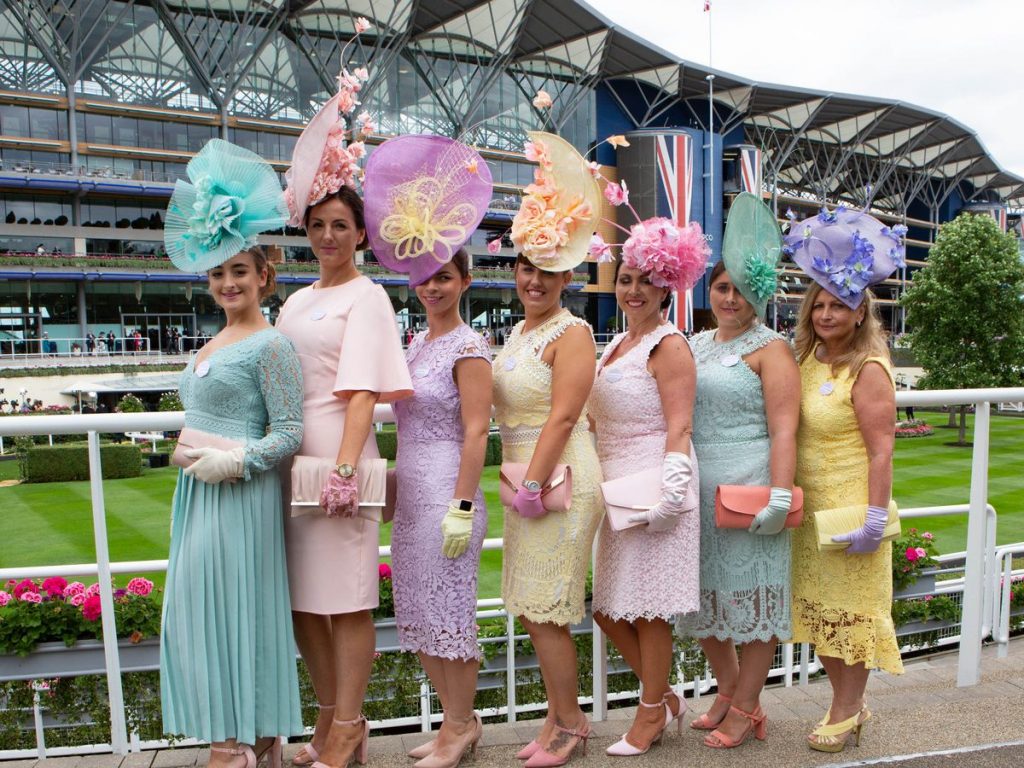
ST:
Can you discuss a bit more the paintings that we are presenting in Dog Show?
LB:
I love that social media is full of snapshots of pedigree dogs taken and shared by their loving owners. It seems that their dogs are at once status symbols and members of the family. The relationship between the dogs and humans is an important one and it has been recorded by artists for centuries. Dog paintings convey status, loyalty and protection. Mine do as well, but I am also really drawn to the performance and pageantry of dog shows. The bright green carpet of the arena acts like a green screen and the dogs play the lead roles while the humans are supporting characters. There is something captivating and endearing about the dog’s expressions and I like to think of these paintings as little scenes from one big performance.
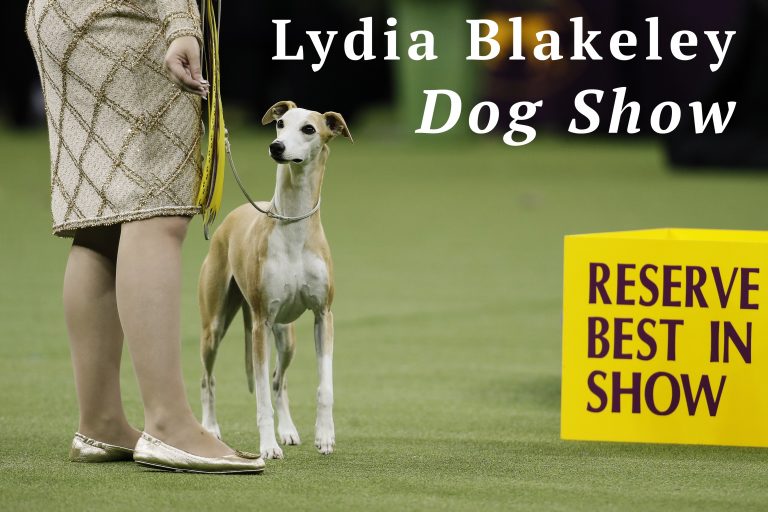
Please direct inquiries to:
steve@steveturner.la
jonathan@steveturner.la
